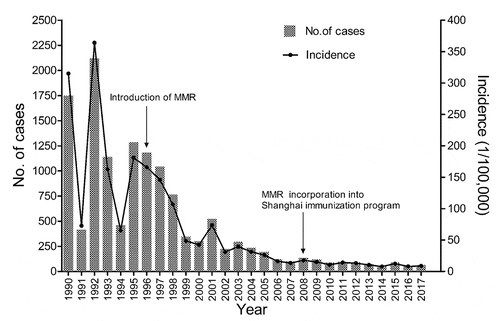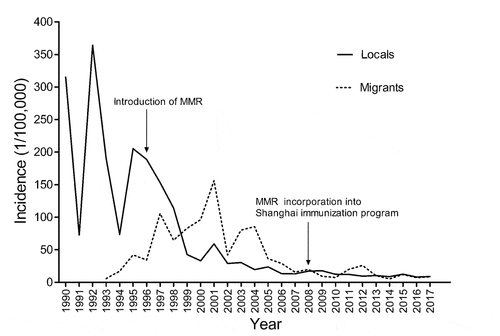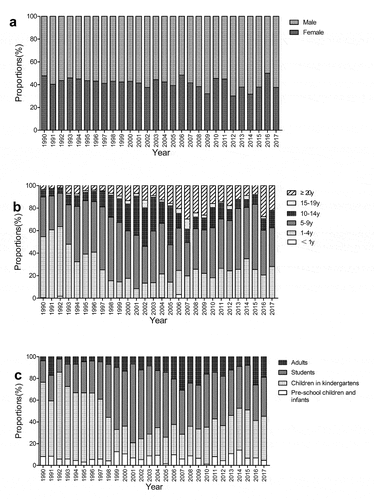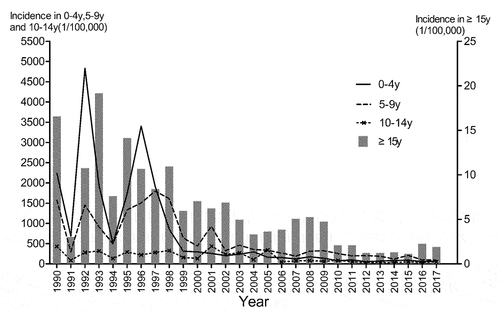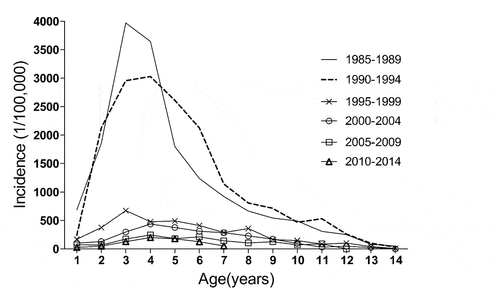ABSTRACT
2-dose measles-mumps-rubella (MMR) vaccine was recommended for children in Shanghai in November 1996 and incorporated into Shanghai immunization program in December 2008. We described the mumps epidemiology and assessed impact of the 2-dose MMR vaccination in Changning district, Shanghai, 1990–2017. We obtained the MMR vaccination coverage for children born during 1995–2015 and examined the incidence and disease characteristics of mumps during 1990–2017. The 1st dose MMR coverage had maintained above 95% since 1999 birth cohort. The 2nd dose MMR coverage reached above 90% since 2006 birth cohort. A total of 13,388 cases were reported during 1990–2017. The incidence decreased from 315.2 per 100,000 population in 1990 to 8.8 per 100,000 population in 2017. Of the 13,388 cases, 7585 (56.7%) were male and 91.7% were 1–14 years of age and 86.8% were children in kindergartens and students in schools. Compared with 1990–1996, the incidence had a significant decrease in 0–4 and ≥15 years in 1997–2008 and in all age groups in 2009–2017. A later birth cohort was associated with a lower incidence in children covered by MMR vaccination. In Conclusions, the incidence of mumps has dramatically declined with high coverage of 2-dose MMR in Changning district, Shanghai. Children in kindergartens and schools are still the most affected populations. An increase in incidence in adults has not occurred after 20 years of MMR vaccination. Long-term surveillance is needed to fully evaluate the impact of MMR vaccination policy.
1. Introduction
Mumps is known as a common infectious disease in children, characterized by swelling of the parotid and other salivary glands. Although this infection in the majority cases is mild, its complications, such as aseptic meningitis, orchitis, and pancreatitis are serious. Mumps cases have been frequently reported in China in school-age children younger than 15 years, particularly aged 5–9 years.Citation1,Citation2
In countries where large-scale immunization against mumps has been implemented, the incidence of the disease has dropped dramatically.Citation3 As of January 2020, 122 (62.9%) of the 194 WHO member states use mumps vaccines in their national immunization program, most of which used the combined measles-mumps-rubella (MMR) vaccine.Citation4 In November 1996, Shanghai started mumps vaccination in the form of MMR with a 2-dose schedule, administered at 12–18 months and 4 years of age on a voluntary and self-paid basis. In December 2008, the 2-dose MMR schedule was incorporated into Shanghai immunization program and routinely offered free of charge to children aged 18 months and 4 years. Different vaccine strains have been used as the mumps vaccine antigen in Shanghai. The Jeryl-Lynn strain (Merk) was administered since 1996, and it coexisted with the RIT4385 strain (GlaxoSmithKline) in 2005–2008. RIT4385 strain and S79 strain (Shanghai Institute of Biological Products) were administered in 2009–2012. In 2013–2017, only the S79 strain was administered in Shanghai. According to the Changning CDC, the S79 strain accounted for the majority (about 57%) of MMR vaccination counts in Changning in 1996–2017, followed by the Jeryl-Lynn strain (about 28%) and the RIT4385 strain (about 15%). Meta-analysis showed that mumps-containing vaccine was effective at preventing mumps in the Chinese population.Citation5 With widespread use of MMR in target children, the incidence of mumps in Shanghai decreased gradually from 247.6 per 100,000 population in 1990 to 11.0 per 100,000 population in 2015, resulting in 95% decline in reported mumps incidence.Citation6
A resurgence of mumps epidemic in highly vaccinated adolescents and young adults has occurred in recent years in many countries. The most recent examples are the outbreaks in the United States and several European countries.Citation7,Citation8 This sparked us to focus on the epidemiology characteristics of mumps in Shanghai, where the MMR vaccination has been implemented for more than 20 years. 2-dose MMR schedule can achieve the goal of controlling measles, mumps, and rubella simultaneously. Despite the current vaccination program, approximately average 3,000 mumps cases per year were reported in Shanghai in the past decade, which was almost ten-times compared to those of measles and rubella.Citation9 This epidemiological data suggest that the mumps vaccine and disease control remain a challenge in Shanghai. In addition, pathogen monitoring suggests that genotype F of mumps virus is the predominant genotype in China. It was first identified in 1995 and continuously circulated throughout the country since then.Citation1,Citation2,Citation10 Genotype F was also the predominant genotype in Changning in 2017–2018.Citation11 This raises the question of whether the commonly used three vaccine strains, which belong to genotype A, provide adequate long-term protection against genotype F. The persistent occurrence of mumps cases requires careful monitoring and more effective public health measures should be adopted in Shanghai. The aim of this study was to describe the time trends and demographic characteristics of mumps in the urban area of Shanghai during three periods: 1990–1996 (prevaccination period), 1997–2008 (recommended vaccination period, when MMR vaccination was on self-paid basis) and 2009–2017 (mandatory vaccination period, when MMR vaccination was free of charge). Our findings can provide the epidemiological basis for improving immunization strategies for mumps control.
2. Materials and methods
2.1. Study site
Changning district is located in the west of central urban area and bordered the suburbs of Shanghai. It represents the average level of development of Shanghai. Based on the annual census data from Shanghai municipal Bureau of Statistics, Changning has an area of 38 km2 and comprised 720,000 inhabitants in 2017, 140,000 of whom were migrants from other provinces.
2.2. Data
Data on MMR vaccination were retrieved from Shanghai Immunization Program Information System (SIPIS), which was established in 2012. SIPIS is an electronic registry for storing individual-level immunization information for individuals born in 2005 and after. Those born in 1995–2004 could have their immunization information been checked through paper-based records kept by immunization clinics of Changning. We used children enrolled in immunization record system (paper-based immunization card/SIPIS) in the end of 2016 to define birth cohorts from 1995 to 2015. We calculated the 1st and 2nd dose of MMR (MMR1 and MMR2) vaccination coverage by using the number of children who had received the MMR1and MMR2 till the end of the 2nd and 5th year, respectively, after their birth divided by the total number of children in the corresponding birth cohorts.
Data on mumps cases between January 2005 and December 2017 were obtained from the National Notifiable Diseases Reporting System (NNDRS), which was established in 2004 in China. Mumps cases between January 1990 and December 2004 could be obtained from paper-based infectious disease report cards by the Changning CDC. Information on the notified cases included case number, date of symptom onset, and demographic characteristics, such as gender, birth date, occupation, household registration, and residential address. All mumps cases were identified according to the diagnostic criteria for mumps approved by the Ministry of Health of China.Citation12 The diagnosis of the case was based on clinical manifestations and associated laboratory test results.
In Shanghai, a mumps outbreak is defined as the occurrence of five mumps cases in a community, school, company, or other setting within 14 days. For each reported mumps outbreak, Changning CDC conducted a field investigation to collect information on demographic characteristics (birthday, gender, and occupation), clinical presentations, onset date of symptoms, MMR immunization status and contacts.
2.3. Statistical analysis
Overall and household registration, age, and birth cohort-specific incidence rates of mumps were calculated. Since we lacked detailed information about migrants in terms of age groups or birth cohorts, the age and birth cohort-specific incidence of mumps were calculated only for local population. Demographic characteristics of mumps cases such as sex, age, and occupation were analyzed. Several statistical indicators in the research can be calculated as follows: the annual incidence rate = the annual number of cases/the annual population*100,000; the average sex ratio: the total male cases/the total female cases; the average annual incidence rate: the average annual number of cases/the average population*100,000. Student’s t test was used to compare MMR coverage rates. Period rate ratio for incidence (IRR) was calculated using negative binomial regression. The first period (1990–1996) was taken as the reference and then the IRR was expressed as the ratio between the period rates (overall and by age group).
The data were analyzed with Stata12.0 (Statacorp LP, USA), with a two-sided significance level of p < .05.
3. Results
3.1. MMR vaccination coverage
The total coverage rate of MMR1 increased from 80.5% in 1995 birth cohort to 94.9% in 1998 birth cohort and had maintained above 95% since 1999 birth cohort (). The total coverage rates of MMR2 maintained under 40% in 1995–2001 birth cohorts and mounted from 57.9% in 2002 birth cohort to 82.9% in 2005 birth cohort, following which had been above 90% since 2006 birth cohort ().
Figure 1. Vaccination coverage rates of MMR in Shanghai Changning. (a) The 1st dose of MMR vaccination coverage for children born during 1995–2015. (b) The 2nd dose of MMR vaccination coverage for children born during 1995–2012

For birth cohorts 1995–2005 (offered MMR1 on self-paid basis), MMR1 coverage rates were 82.0–99.1% (mean: 94.8%, median: 97.2%) in local children and 77.7–93.4% (mean: 89.7%, median: 91.1%) in migrant children. Local children had higher MMR1 coverage than migrants (Student’s t test: t = 2.133, p = .045). For birth cohorts 2006–2015 (birth cohorts 2007–2015 offered MMR1 free of charge), MMR1 coverage rates had maintained over 95% both in local and migrant children.
For birth cohorts 1995–2004 (offered MMR2 on self-paid basis), MMR2 coverage rates were 17.6–82.3% (mean: 43.0%, median: 37.4%) in local children and 13.9–57.7% (mean: 31.3%, median: 28.0%) in migrant children. No significant difference was found in MMR2 coverage between locals and migrants (Student’s t test: t = 1.435, p = .169). For birth cohorts 2005–2012 (offered MMR2 free of charge), MMR2 coverage rates were above 95% since 2007 birth cohort in local children and since 2010 birth cohort in migrant children.
3.2 Mumps epidemiological features
3.2.1. Overall assessment
During 1990–2017, 13,388 cases of mumps were reported to the Changning CDC. The annual incidence rate decreased by 97.2% from 315.2 per 100,000 population (1749 cases) in 1990 to 8.8 per 100,000 population (64 cases) in 2017. In 1990–1996, mumps was characterized by interepidemic periods of 1–2 years, with an incidence peak of 364.2 per 100,000 population (2121 cases) recorded in 1992. In 1997–2008, the incidence decreased gradually from 146.0 per 100,000 population (1045 cases) in 1997 to 17.8 per 100,000 population (136 cases) in 2008, with a small epidemic peak in 2001. In 2009–2017, the incidence ranged between 7.9 per 100,000 population (57 cases, 2014) and 15.1 per 100,000 population (122 cases, 2009), with no apparent epidemic peaks ().
3.2.2. Outbreaks
Shanghai started mumps outbreaks surveillance since 2001. During 2001–2017, a total of 12 outbreaks with 202 cases were reported to the Changning CDC. In each outbreak, the average number of outbreak-related cases was 17. The outbreaks all occurred in primary school or middle school between 2001 and 2005. Since 2006, no outbreak had been reported. All the 202 outbreak-related cases were born between 1988 and 1996. Of the 202 cases, 195(96.5%), 7(3.5%) and 0 (0%) had received 0 dose, 1 dose, and 2 doses of MMR, respectively.
3.2.3. Incidence by household registration
Mumps became a notifiable disease in Shanghai in 1990 for local population and in 1993 for migrants. During 1990–2017, local cases accounted for a majority (12147 cases, 90.7%) compared to the migrant cases (1241 cases, 9.3%). The fluctuation of mumps incidence between local and migrant population followed different patterns in 1997–2008. The incidence of mumps decreased rapidly in local population since the introduction of MMR in 1996, while it maintained periodic epidemics with epidemic peaks every 3–5 years and reached a peak of 156.1 per 100,000 population (164 cases) in 2001 in migrants. In 2009–2017, the incidence of mumps in locals and migrants both maintained relatively at low levels. The average annual incidence of mumps was 11.2 per 100,000 population in locals and 11.7 per 100,000 population in migrants ().
3.2.4. Distribution by sex, age and occupation
Of the 13,388 mumps cases, 7585 (56.7%) were male and 5803(43.3%) were female, with average annual ratios of 1.3: 1, 1.4: 1, and 1.7: 1 in 1990–1996, 1997–2008, and 2009–2017, respectively. The majority (12,275, 91.7%) of the cases was 1–14 years of age. 54 cases (0.4%) were <1 year of age and 1059 cases (7.9%) were ≥15 years of age. The proportion of cases in children aged 1–4 years decreased from 50.2% in 1990–1996 to 17.6% in 1997–2008 and increased to 24.7% in 2009–2017. Children aged 5–9 years accounted for 37.6% of cases in 1990–1996, which increased in 48.5% in 1997–2008 and decreased in 44.8% in 2009–2017. The proportion of cases in children aged 10–14 years increased from 6.7% in 1990–1996 to 21.9% in 1997–2008 and decreased to 11.6% in 2009–2017. Adolescents and adults aged ≥15 years accounted for only 4.9% of cases in 1990–1996, which increased to 11.8% in 1997–2008 and further increased to 18.9% in 2009–2017.The median age of cases increased from 4 years (interquartile range: 3–7 years) in 1990–1996 to 7 years (interquartile range: 5–10 years) in 1997–2008 and maintained at 7 years (interquartile range: 5–10 years) in 2009–2017. 11615 cases (86.8%) occurred among children in kindergartens and students in schools, followed by adults (7.0%) and pre-school children and infants (6.3%)().
3.2.5. Mumps incidence by age in local population
In 1990–1996, the most affected age group was 0–4 years with the average annual incidence rate of 2043.3 per 100,000 population, followed by 5–9 years (1066.0/100,000) and 10–14 years (246.7/100,000). In 1997–2008 and 2009–2017, children aged 5–9 years became the age group with the highest incidence of mumps (783.5/100,000 in 1997–2008 and 176.1/100,000 in 2009–2017), followed by those aged 0–4 years (423.2/100,000 in 1997–2008 and 78.9/100,000 in 2009–2017) and 10–14 years (228.7/100,000 in 1997–2008 and 47.1/100,000 in 2009–2017). Adolescents and adults aged ≥15 years had the lowest incidence of mumps in the three periods (11.7/100,000 in 1990–1996, 5.9/100 000 in 1997–2008 and 2.0/100 000 in 2009–2017) (, ). After the introduction of MMR in 1996, the incidence had a decreasing trend in all age groups. The small epidemic peak in 2001 was caused by an increasing incidence in 5–9 and 10–14 years age group ().
Table 1. Mumps incidence rates, incidence rate ratios (IRR) by period and age group
Taking the period of 1990–1996 as a reference, negative binomial regression showed that the incidence had a significant decrease among children aged 0–4 years and adolescents and adults aged ≥15 years, while it had a small but non-significant decrease in children aged 5–9 and 10–14 years in 1997–2008 (). Mumps incidence trends over time were different by age group, suggesting the possibility of a cohort effect. Compared to 1990–1996, the incidence had a significant decrease in all age groups in 2009–2017, with the largest decline in children aged 0–4 years (IRR = 0.04) ().
3.2.6. Incidence by birth cohort in local population
According to the use of MMR, 1985–1989 and 1990–1994 birth cohorts were those who were presumably unvaccinated or with very limited vaccination coverage of MMR. High mumps incidences were evident in these two birth cohorts and an increased incidence was observed in 1990–1994 birth cohort in 5–14 years ().
The cohorts born from 1995 to 2014 represented those who were covered by MMR vaccination. In general, the incidence of mumps decreased in all birth cohorts and the peak of the incidence of 3–6 years was observed in every birth cohort. A later birth cohort was associated with a lower incidence in children of the same age, suggesting that the age distribution of mumps cases had not yet shifted to the older age group in vaccine-covered children.
4. Discussion
MMR was available in Shanghai in 1996. As a more developed city in China, the coverage of MMR1 still reached 80.5% in 1995 birth cohort and maintained above 95% since 1999 birth cohort even on a voluntary and self-paid basis. According to Shanghai immunization program, 2-dose measles vaccine was routinely offered free of charge to children aged 8 months and 4 years between 1996 and 2005. The vaccination of MMR2 for children aged 4 years coincided with the 2nd dose of measles vaccine and the coverage of MMR2 maintained fewer than 40% in 1995–2001 birth cohorts. In 2006, when the 2nd dose of measles vaccine was moved from 4 years to 18 months of age, the coverage of the 2nd dose of MMR began to mount rapidly and reached 90% since 2006 birth cohort in mandatory vaccination period.
Our study showed that high coverage of MMR in susceptible children was associated with significant decline in mumps incidence rate and the control of mumps outbreaks in Shanghai Changning. The average annual incidence rate of mumps decreased dramatically from 199.1 per 100,000 population in the prevaccination period to 45.6 per 100,000 population in recommended period, followed by a further decrease to 10.0 per 100,000 population in mandatory period (). Identical decreases in incidence were found in countries recommending vaccination against mumps. In 1967, mumps vaccine was licensed in the United States, and by 2005 high 2-dose childhood vaccination coverage reduced disease rates by >99%.Citation13 In England, hospital admissions for mumps encephalitis decreased by 98% after the introduction of MMR in 1988.Citation14 Finland introduced national mumps vaccination in 1982 and was free of indigenous mumps 16 years later.Citation15 Other American and European countries have experienced similarly substantial reductions. Among the countries using a 2-dose schedule, the reductions ranged from 97% to more than 99%. Among countries using a 1-dose schedule, the reductions ranged from 88% to 98%.Citation16
MMR consists of live-attenuated mumps virus and the vaccination of MMR is similar to the natural infection of mumps virus. Widespread use of MMR could protect the majority of susceptible children and block the transmission of mumps. For birth cohorts 1995–2004, local and migrant children both had lower average vaccination coverage rate of MMR2, but local children had higher MMR1 coverage than migrants for birth cohorts 1995–2005. Correspondingly, the fluctuation of mumps incidence between locals and migrants followed different patterns in 1997–2007. A rapid decline in mumps incidence in locals and periodic epidemics of mumps in migrants were observed, suggesting a high coverage of MMR was needed to block transmission of mumps when 1-dose of MMR was used for mumps control. There are different assessments regarding the herd immunity threshold for mumps. According to two mathematical models, the herd immunity threshold of 85–90% would be needed to prevent circulation of the mumps virusCitation17,Citation18 and one study estimated the threshold of 88–92%.Citation19 We assumed 90% as the herd immunity threshold for mumps. The meta-analysis showed that initial seroconversion rates for mumps virus-neutralizing antibodies after MMR vaccination with Jeryl-Lynn strain were 92–98%.Citation20 A seroconversion rate for mumps antibodies reported in children aged 12–16 months was 95.2% in Shanghai in 1998.Citation21 We assumed 95% as the initial seroconversion rate for mumps antibodies. To block transmission of mumps, the coverage of one dose MMR was then calculated to be at least 95% (95% coverage rate*95% seroconversion rate = 90% herd immunity threshold). Nevertheless, even 95% coverage brings the population immunity (90%) effectiveness near the putative herd immunity threshold, areas of high population densities, and high contact rates (like kindergartens and schools), which facilitate transmission, may require an increased level of group-specific immunity.Citation22,Citation23 Thus, 2-dose MMR inoculation in children seemed necessary to provide another opportunity to the recipients, who might have had primary immune failure or be missing an inoculation. In China, a routine 1-dose MMR vaccine schedule has been offered to children aged 18–24 months since 2008. However, mumps has not been as effectively controlled as our study reported.Citation1,Citation2,Citation24 Low coverage rate of MMR in underdevelopment region in China and 1-dose MMR strategy could be important reasons.
In our study, the proportion of mumps cases in 5–9 years, 10–14 years and ≥15 years all increased after the introduction of MMR. The median age of cases shifted from 4 years in prevaccination period to 7 years in the two vaccination periods. Negative binomial regression confirmed that no statistically significant decreases in mumps incidence rates were observed in 5–9 and 10–14 years in 1997–2008 compared to the period of 1990–1996. Birth cohort effect may have affected the age-shift over time. When MMR was initially used in Shanghai in 1996, it was recommended to children on a voluntary and self-paid basis. There was no catch-up vaccination of MMR in susceptible children aged 1–14 years. Children born before 1995 were presumably unvaccinated or with very limited vaccination coverage of MMR. Mumps incidence by birth cohort showed high incidences were evident in 1985–1989 and 1990–1994 birth cohorts. These birth cohorts were often considered as “lost cohorts,” who were too old to have been offered MMR vaccination routinely but nevertheless grew up at a time when mumps circulation had been reduced sufficiently for them not to acquire natural immunity. A lack of catch-up vaccination activities may have left a pool of susceptible that account for the shift in age distribution. Moreover, later birth cohort often associated with less chance of natural infection. As a result, the highest incidence in 5–14 years was observed in 1990–1994 birth cohort. The cohorts born after 1994 represented those who covered by MMR vaccination. Sharp reductions in mumps incidence were observed in 1995–2014 birth cohorts in children aged 1–14 years. We did not observe shift over time in age groups. In each birth cohort, 3–6 years were mostly affected, which was still similar to the age distribution in prevaccination period.
A resurgence of mumps epidemic in highly vaccinated adolescents and young adults has occurred in recent years in many countries, which could be explained by insufficient vaccine effectiveness, waning immunity, periodicity of the disease or genetic divergences of vaccine and wild-type strains.Citation25–28 In Shanghai Changning, the majority of mumps cases was still reported among children in kindergartens and schools after 20 years of MMR vaccination and no mumps epidemic among adolescents or young adults was reported in the vaccine era. Reasons might be: (1) People aged ≥20 years in Shanghai Changning were mostly born in the prevaccine era. They might develop immunity through natural infection in their childhood. (2) Before the resurgence of vaccinated cases, mumps incidence in those countries was much lower than in Changning. In the United States, for example, the mumps incidence reached about one in a million before the resurgence of mumps epidemic. Mild circulating levels of wild virus in Changning might help to stimulate immunological memory in vaccinated persons and therefore protect them from mumps disease. (3) With sustaining decline in mumps incidence and complication rate in vaccine era, expectations that mumps appears in pediatric rather than adult population may bias disease reporting, especially when mumps surveillance is based on clinical diagnosis.
The strengths of our study are deserved to mention. We obtained data on mumps cases for 28 years including prevaccination and vaccination periods in Shanghai Changning. In addition, we obtained clear data on MMR vaccination coverage in target children which allowed analyzing the relationship between vaccination coverage and mumps epidemiological characteristics.
There are at least three limitations in our study. First, most mumps cases were clinically diagnosed. Misdiagnosis of cases was likely to occur. Considering most of the cases should have been vaccinated with MMR, the number of cases in vaccination period may therefore be overestimated. Nonetheless, the data obtained via a national surveillance-based method is a reasonable surrogate for population-level data. Second, because of the characteristics of the observed approach, the findings in this study can only suggest causation, but cannot prove it. Third, MMR immunization coverage among the population born before 1995 was unknown in our study. But that coverage was very likely to be lower than that among the population born in or after 1995.
5. Conclusions
Our study shows that the overall incidence rates of mumps have dramatically declined with high coverage rate of 2-dose of MMR in mandatory vaccination period in Shanghai Changning. To achieve the goal of further controlling mumps while maintaining the high coverage rate of MMR, the inclusion of sensitive diagnostic technology such as PCR in the case definition of mumps seems necessary to establish whether the mumps virus remains in circulation in Shanghai. In addition, when young adults born before the introduction of MMR is gradually replaced by the population whose protection against mumps comes only through vaccination, the long-term surveillance of the impact of the MMR vaccination policy is greatly needed.
Disclosure of potential conflicts of interest
The authors declare that they have no known competing financial interests or personal relationships that could have appeared to influence the work reported in this paper.
Additional information
Funding
References
- Cui A, Zhu Z, Chen M, Zheng H, Liu L, Wang Y, Ma Y, Wang C, Fang X, Li P, et al. Epidemiologic and genetic characteristics of mumps viruses isolated in China from 1995 to 2010. Infect Genet Evol. 2014;21:384–90. doi:10.1016/j.meegid.2013.12.005.
- Cui A, Zhu Z, Hu Y, Deng X, Sun Z, Zhang Y, Mao N, Xu S, Fang X, Gao H, et al. Mumps epidemiology and mumps virus genotypes circulating in mainland China during 2013–2015. PLoS ONE. 2017;12(1):e0169561. doi:10.1371/journal.pone.0169561.
- Galazka AM, Robertson SE, Kraigher A. Mumps and mumps vaccine: a global review. Bull World Health Organ. 1999;77(1):3–14. PMID:10063655.
- World Health Organization. Immunization surveillance, assessment and monitoring. [accessed 2020 Mar 23]. http://www.who.int/immunization/monitoring_surveillance/en/
- Wang H, Hu Y, Zhang G, Zheng J, Li L, An Z. Meta-analysis of vaccine effectiveness of mumps-containing vaccine under different immunization strategies in China. Vaccine. 2014;32:4806–12. doi:10.1016/j.vaccine.2014.05.061.
- Wu L, Hu J, Li Z, Yang J, Sun X. Epidemiology of mumps in Shanghai, 1990–2015. Chin J Vaccines Immunization. 2018;24(1):43–47. [in Chinese].
- Centers for Disease Control and Prevention. National Center for Immunization and Respiratory Diseases. Update on mumps epidemiology in the United States, 2017 and review of studies of 3rd dose of MMR vaccine. [accessed 2018 Mar 3]. https://www.cdc.gov/vaccines/acip/meetings/downloads/slides-2017-06/mumps-02-marin.pdf
- European Centre for Disease Prevention and Control. Mumps-Annual epidemiological report for 2015. [accessed 2018 Mar 3]. https://ecdc.europa.eu/en/publications-data/mumps-annual-epidemiological-report-2015
- Shanghai Municipal Health Commission. Update of notifiable disease figure of Shanghai. [accessed 2020 Feb 1]. http://wsjkw.sh.gov.cn/yqxx/index.html [in Chinese].
- Cui A, Rivailler P, Zhu Z, Deng X, Hu Y, Wang Y, Li F, Sun Z, He J, Si Y, et al. Evolutionary analysis of mumps viruses of genotype F collected in mainland China in 2001–2015. Sci Rep. 2017;7(1):17144. doi:10.1038/s41598-017-17474-z.
- Pang H, Guo J, Liu X, Xiong C, Jiang L, Jiang Q. Genetic characteristics of mumps virues isolated in Changning district of Shanghai, 2017–2018. Chin J Vaccines Immunization. 2019;25(6):650–54. [in Chinese].
- National Health Commission of the People’s Republic of China. Diagnostic criteria for mumps (WS270-2007). [accessed 2020 Feb 1]. http://www.nhc.gov.cn/wjw/s9491/200704/38797/files/4b993dfd62834ccda16b8240ab078a00.pdf [in Chinese]
- Barskey AE, Glasser JW, LeBaron CW. Mumps resurgences in the United States: a historical perspective on unexpected events. Vaccine. 2009;27(44):6186–95. doi:10.1016/j.vaccine.2009.06.109.
- Iro MA, Sadarangani M, Goldacre R, Nickless A, Pollard AJ, Goldacre MJ. 30-year trends in admission rates for encephalitis in children in England and effect of improved diagnostics and measles-mumps-rubella vaccination: a population-based observational study. Lancet Infect Dis. 2017;17(4):30114–17. doi:10.1016/S1473-3099(17)30114-7.
- Peltola H, Davidkin I, Paunio M, Valle M, Leinikki P, Heinonen OP. Mumps and rubella eliminated from Finland. JAMA. 2000;284(20):2643–47. doi:10.1001/jama.284.20.2643.
- Hviid A, Rubin S, Mühlemann K. Mumps. Lancet. 2008;371(9616):932–44. doi:10.1016/S0140-6736(08)60419-5.
- Edmunds WJ, Gay NJ, Kretzschmar M, Pebody RG, Wachmann H. The pre-vaccination epidemiology of measles, mumps and rubella in Europe: implications for modeling studies. Epidemiol Infect. 2000;125(3):635–50. doi:10.1017/s0950268800004672.
- Anderson RM, Crombie JA, Grenfell BT. The epidemiology of mumps in the UK: a preliminary study of virus transmission, herd immunity and the potential impact of immunization. Epidemiol Infect. 1987;99(1):65–84. doi:10.1017/s0950268800066875.
- Anderson RM, May RM. Vaccination and herd immunity to infectious diseases. Nature. 1985;318(6044):323–29. doi:10.1038/318323a0.
- Wellington K, Goa KL. Measles, mumps, rubella vaccine (Priorix; GSK-MMR): a review of its use in the prevention of measles, mumps and rubella. Drugs. 2003;63(19):2107–26. doi:10.2165/00003495-200363190-00012.
- Xu T, Shi Y, Wu W, Li X, Wang G, Xu Q. Immune effect survey and immunization procedure for measles-mumps-rubella vaccine. Chin J Vaccines Immunization. 1999;5(1):11–13. [in Chinese].
- Briss PA, Fehrs LJ, Parker RA, Wright PF, Sannella EC, Hutcheson RH, Schaffner W. Sustained transmission of mumps in a highly vaccinated population: assessment of primary vaccine failure and waning vaccine-induced immunity. J Infect Dis. 1994;169(1):77–82. doi:10.1093/infdis/169.1.77.
- Nelson GE, Aguon A, Valencia E, Oliva R, Guerrero ML, Reyes R, Lizama A, Diras D, Mathew A, Camacho EJ, et al. Epidemiology of a mumps outbreak in a highly vaccinated island population and use a third dose of measles-mumps-rubella vaccine for outbreak control-Guam 2009 to 2010. Pediatr Infect Dis J. 2013;32(4):374–80. doi:10.1097/INF.0b013e318279f593.
- Yu G, Yang R, Wei Y, Yu D, Zhai W, Cai J, Long B, Chen S, Tang J, Zhong G, et al. Spatial, temporal, and spatiotemporal analysis of mumps in Guangxi Province, China, 2005–2016. BMC Infect Dis. 2018;18(1):360. doi:10.1186/s12879-018-3240-4.
- Anis E, Grotto I, Moerman L, Warshavsky B, Slater PE, Lev B. Mumps outbreak in Israel’s highly vaccinated society: are two doses enough? Epidemiol Infect. 2012;140(3):439–46. doi:10.1017/S095026881100063X.
- Lebaron CW, Forghani B, Beck C, Brown C, Bi DL, Cossen C, Sullivan BJ. Persistence of mumps antibodies after 2 doses of measles-mumps-rubella vaccine. J Infect Dis. 2009;199(4):552–60. doi:10.1086/596207.
- Vandermeulen C, Lerouxroels G, Hoppenbrouwers K. Mumps outbreaks in highly vaccinated populations: what makes good even better? Hum Vaccin. 2009;5(7):494–96. doi:10.4161/hv.7943.
- Sabbe M, Vandermeulen C. The resurgence of mumps and pertussis. Hum Vaccin Immunother. 2016;12(4):955–59. doi:10.1080/21645515.2015.1113357.

